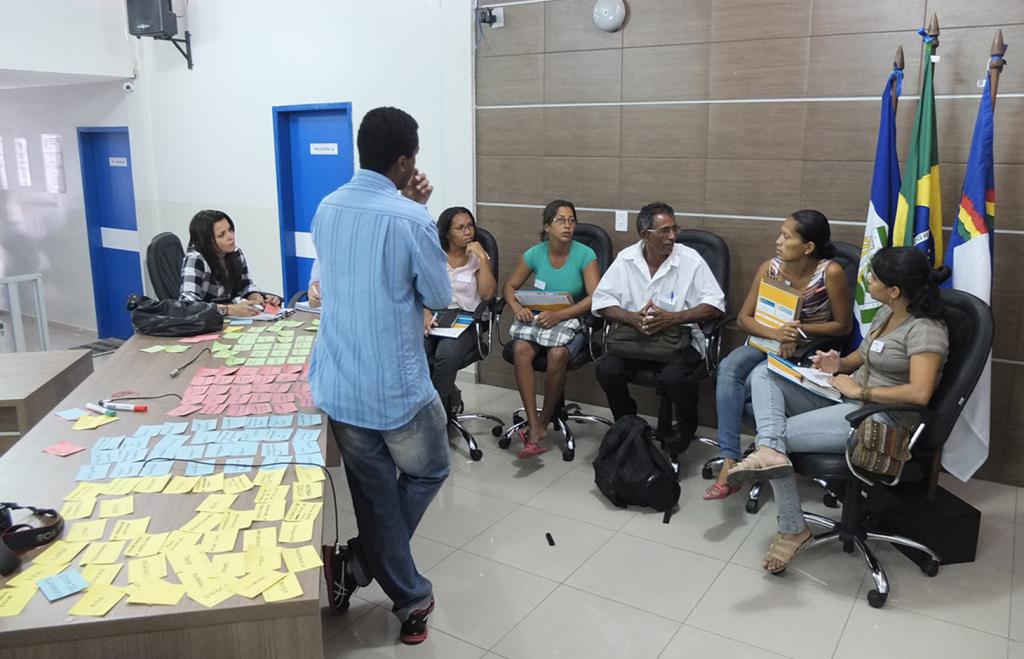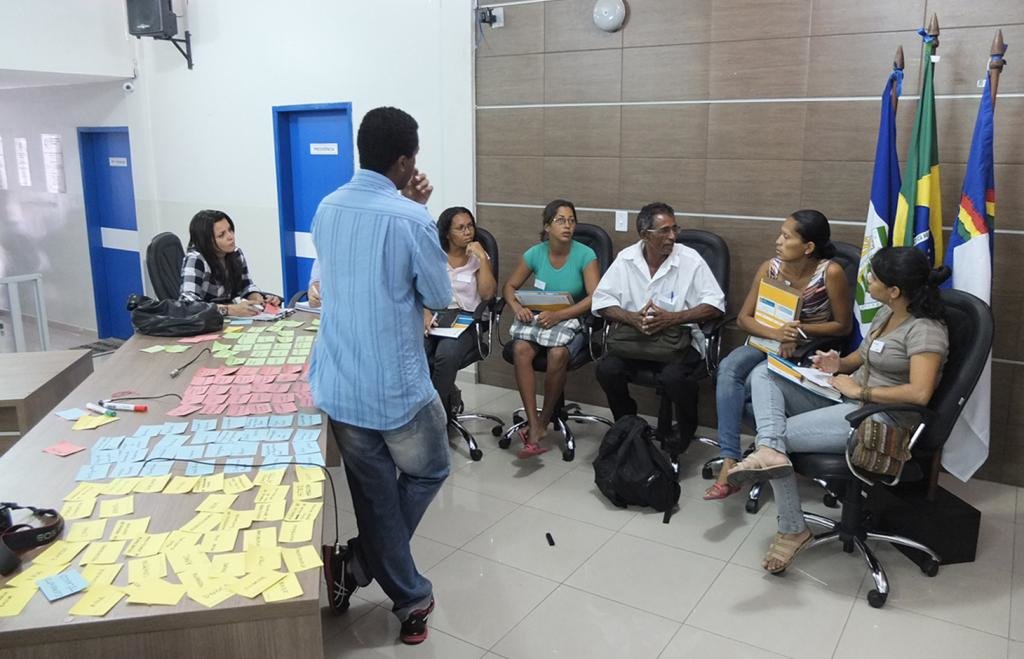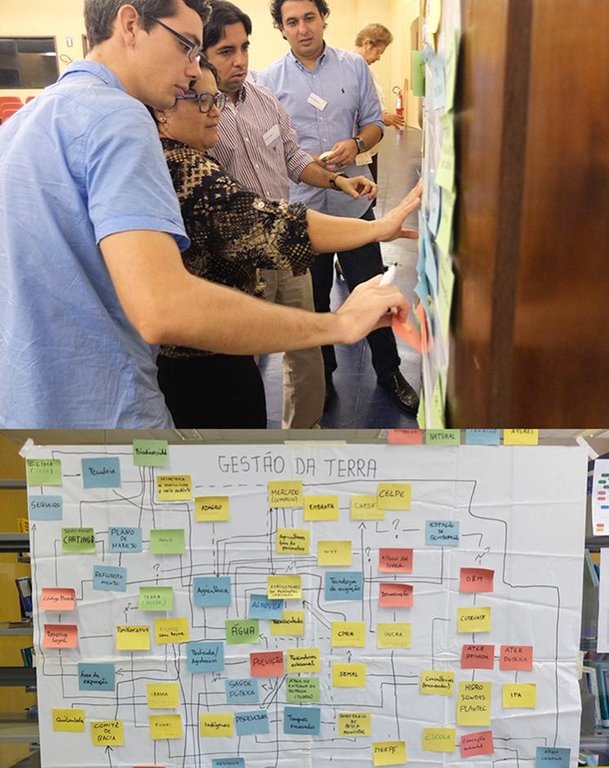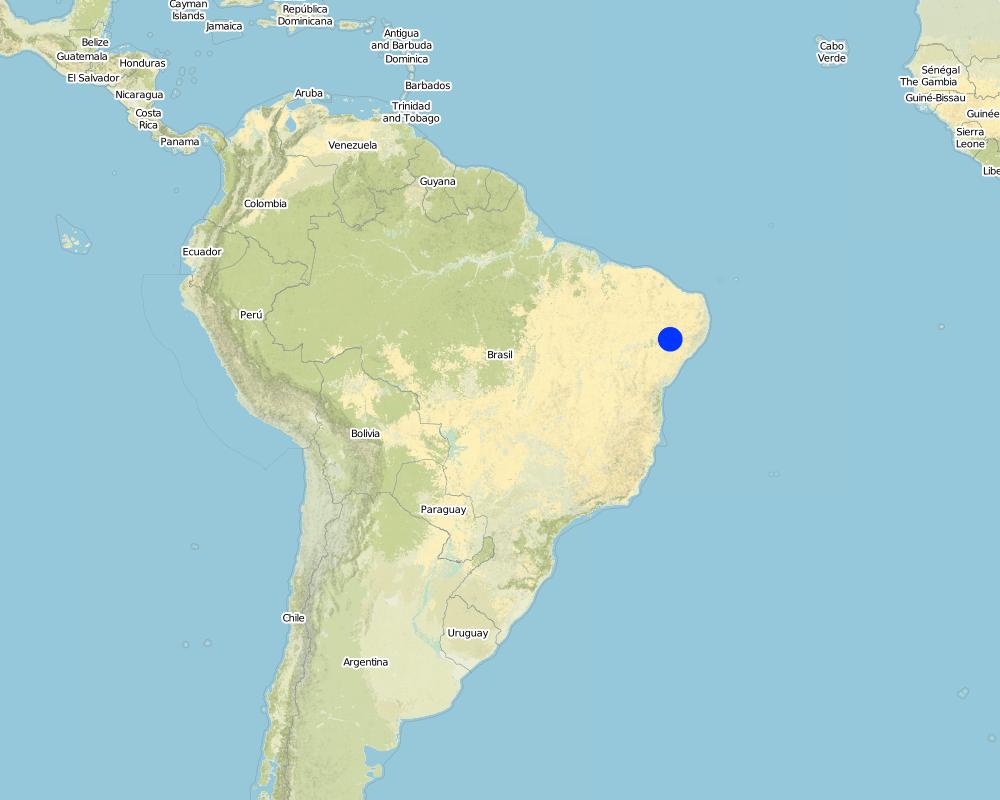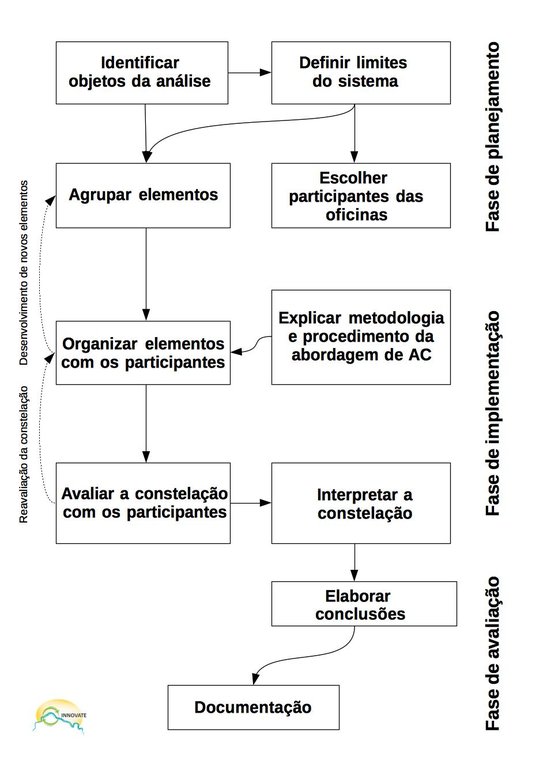Constellation Analysis [ប្រទេសប្រេស៊ីល]
- ការបង្កើត៖
- បច្ចុប្បន្នភាព
- អ្នកចងក្រង៖ Verena Rodorff
- អ្នកកែសម្រួល៖ –
- អ្នកត្រួតពិនិត្យ Deborah Niggli
Análise de Constelação
approaches_1974 - ប្រទេសប្រេស៊ីល
ពិនិត្យមើលគ្រប់ផ្នែក
ពង្រីកមើលទាំងអស់ បង្រួមទាំងអស់1. ព័ត៌មានទូទៅ
1.2 ព័ត៌មានលម្អិតពីបុគ្គលសំខាន់ៗ និងស្ថាប័នដែលចូលរួមក្នុងការវាយតម្លៃ និងចងក្រងឯកសារនៃវិធីសាស្ត្រផ្សព្វផ្សាយ
អ្នកជំនាញឯកទេស SLM:
ឈ្មោះគម្រោងដែលបានចងក្រងឯកសារ/ វាយតម្លៃលើវិធីសាស្ត្រផ្សព្វផ្សាយ (បើទាក់ទង)
Book project: Making sense of research for sustainable land management (GLUES)1.3 លក្ខខណ្ឌទាក់ទងទៅនឹងការប្រើប្រាស់ទិន្នន័យដែលបានចងក្រងតាមរយៈវ៉ូខេត
តើពេលណាដែលទិន្នន័យបានចងក្រង (នៅទីវាល)?
23/06/2015
អ្នកចងក្រង និង(បុគ្គលសំខាន់ៗ)យល់ព្រមទទួលយកនូវលក្ខខណ្ឌនានាទាក់ទងទៅនឹងការប្រើប្រាស់ទិន្នន័យដែលបានចងក្រងតាមរយៈ វ៉ូខេត:
បាទ/ចា៎
2. ការពណ៌នាអំពីវិធីសាស្ត្រផ្សព្វផ្សាយ SLM
2.1 ពណ៌នាសង្ខេបខ្លីពីវិធីសាស្ត្រផ្សព្វផ្សាយ
Constellation Analysis is a tool used to clarify perceptions of different stakeholders about critical situations or problems. In workshops, participants visualize interrelationships between actors, as well as the associated natural, technical and regulatory factors.
2.2 ពណ៌នាលម្អិតពិវិធីសាស្ត្រផ្សព្វផ្សាយ
ពណ៌នាលម្អិតពិវិធីសាស្ត្រផ្សព្វផ្សាយ:
The Constellation Analysis method (CA) aims at a transparent, mutually accepted visualization of factors (‘elements’) that are systematically arranged under the method's four categories: actors; rules and concepts; natural elements; technical elements, with the type of their inter-relationships. The process enables consensus to be found between divergent positions, paving the way for better informed decision-making while facilitating a negotiated process of land management with potential changes/techniques.
During brainstorming and/or literature-based approach, different elements are determined and arranged visually on a board. Element categories are actors (e.g. farmers, energy supply company), rules and concepts (e.g. legal framework, plans and programs, regulations), natural factors (e.g. climate, vegetation, water) and technical factors (e.g. fertilizer, wastewater treatment, hydropower plant). Usually this is done by using differently coloured and shaped cards to help articulate ideas within a working group. Then, connections among and between the elements are discussed and the form of these interrelations are visualized as being (a) directed, (b) conflictive, (c) non-existent, (d) contradictory, (e) reluctant or (f) interactive. Through this approach the way towards developing solutions (or follow-up CAs) is guided.
The approach was applied at different scales and with different stakeholders with divergent professional expertise and educational levels, e.g. farmers, fishermen, employees of the government, representatives of indigenous tribes, associations, trade unions, and researchers. People found the methodology promising as it raises awareness and organizes information. Training in the methodology has been carried out amongst interested people at two universities, but not yet local development agents.
The visualization is carried out through an iterative group process. A moderator is needed to initiate the process by inviting the different stakeholders to a conducive location, and to facilitate the process. Exchange among participants is enhanced, and this leads to better understanding of different viewpoints in situations of tension or in the understanding of what has evolved through specific developments in the past. During a second analytical step, the main lessons of the visualization are extracted and documented. Here, missing factors/relationships, and consequently the need for action, are detected. For example, insufficient communication between actors could be uncovered, or it may be detected that planning programs need to be improved.
2.3 រូបភាពនៃវិធីសាស្ត្រផ្សព្វផ្សាយ
2.5 ប្រទេស/តំបន់/ទីតាំងកន្លែង ដែលវិធីសាស្ត្រផ្សព្វផ្សាយត្រូវបានអនុវត្តន៍
ប្រទេស:
ប្រទេសប្រេស៊ីល
តំបន់/រដ្ឋ/ខេត្ត:
Pernambuco, Brazil
បញ្ជាក់បន្ថែមពីលក្ខណៈនៃទីតាំង:
Itaparica Reservoir, Petrolândia
Map
×2.6 កាលបរិច្ឆេទនៃការចាប់ផ្តើម និងបញ្ចប់នៃវិធីសាស្រ្តផ្សព្វផ្សាយនេះ
សូមបញ្ជាក់ឆ្នាំដែលបានបង្កើតឡើង:
2012
ឆ្នាំបញ្ចប់ (ប្រសិនបើវិធីសាស្ត្រផ្សព្វផ្សាយត្រូវបានឈប់ប្រើប្រាស់):
2016
2.7 ប្រភេទនៃវិធីសាស្ត្រផ្សព្វផ្សាយ
- ផ្អែកលើគម្រោង/កម្មវិធី
2.8 គោលបំណង/ទិសដៅសំខាន់នៃវិធីសាស្ត្រផ្សព្វផ្សាយ
The approach can be applied at different levels and for different issues or contexts: all perspectives can be represented and discussed. The application in this case was devised to be an iterative process of consecutive workshops first at the local irrigation project level, and then at the municipal, regional and national levels with the aim of analysing the inhibiting and driving forces behind the current situation in water management, in land management, and around production cycles in agriculture and aquaculture leading to action being taken or decisions made. Farmers and fishermen, employees of government, researchers and experts are considered as the relevant target group to be involved in participatory workshops. In the education sector, the approach can be applied for theses, for field work and for projects as an analytical interdisciplinary approach.
2.9 លក្ខខណ្ឌអនុញ្ញាត ឬរារាំងការអនុវត្តន៍បច្ចេកទេសដែលស្ថិតនៅក្រោមវិធីសាស្រ្តផ្សព្វផ្សាយ
សង្គម/វប្បធម៌/ និងតម្លៃនៃសាសនា
- អំណោយផល
In some cases, segregation of social or gender groups, especially at the beginning of the exercise, can be helpful. No means has yet been found to reduce ‘mobile phone distraction’ in an acceptable way.
បរិបទនៃស្ថាប័ន
- អំណោយផល
Argumentation promoting the value of the process may help to ‘sell’ the approach.
ចំណេះដឹងស្តីពី SLM និងការទទួលបានការគាំទ្រផ្នែកបច្ចេកទេស
- អំណោយផល
It may be possible to organize a pick-up service for participants or to choose an easy-access location.
ទំហំការងារ ភាពអាចរកបាននៃកម្លាំងពលកម្ម
- អំណោយផល
It is important to discuss potential dates in advance. Some people prefer weekends, others don’t. The lunch break is useful for more informal interaction. However others use the break to disappear.
ផ្សេងៗ
- អំណោយផល
The iterative process of the CA promotes a re-assessment of constellations during different group discussions. Views of dominant individuals can be modified in the iterative procedure, especially when participants with different standpoints and positions are involved. The goal is the mutual understanding of divergent positions towards entry points for change or adaptation.
3. ការចូលរួម និងតួនាទីរបស់ភាគីពាក់ព័ន្ធ
3.1 អ្នកពាក់ព័ន្ធដែលបានចូលរួមក្នុងវិធីសាស្ត្រផ្សព្វផ្សាយ និងតួនាទីរបស់ពួកគេ
- អ្នកប្រើប្រាស់ដីក្នុងតំបន់/សហគមន៍
smallholders of local agricultural community
- អ្នកឯកទេសគ្រប់គ្រងដីប្រកបដោយចីរភាព/ទីប្រឹក្សាបច្ចេកទេសកសិកម្ម
- គ្រូបង្រៀន/សិស្សក្មេងៗ/សិស្ស-និស្សិត
students only in observing role
- រដ្ឋាភិបាលថ្នាក់ជាតិ (អ្នករៀបចំផែនការ អ្នកសម្រេចចិត្ត)
3.2 ការចូលរួមរបស់អ្នកប្រើប្រាស់ដីក្នុងតំបន់/ សហគមន៍ក្នុងតំបន់ក្នុងដំណាក់កាលផ្សេងគ្នានៃវិធីសាស្រ្តផ្សព្វផ្សាយ
| ការចូលរួមរបស់អ្នកប្រើប្រាស់ដីក្នុងតំបន់/សហគមន៍ក្នុងតំបន់ | សូមបញ្ជាក់នរណាត្រូវបានចូលរួម ព្រមទាំងពណ៌នាសកម្មភាពទាំងនោះ | |
|---|---|---|
| ការចាប់ផ្តើម/ការលើកទឹកចិត្ត | អសកម្ម | Interviews |
| ការរៀបចំផែនការ | គ្មាន | |
| ការអនុវត្តន៍ | អន្តរកម្ម | Workshops |
| ការត្រួតពិនិត្យ និងវាយតម្លៃ | អន្តរកម្ម | Workshops |
| research | អន្តរកម្ម | Data analysis, lessons learnt, etc |
3.3 គំនូសបំព្រួញ (ប្រសិនបើមាន)
ការពណ៌នា:
Simplified flowchart of the Constellation Analysis Approach.
Planning phase:
Clarify the objective or question behind the analysis. Then, have an overview research about first elements (assembling elements), e.g. which actors can give interesting input and how to contact them. Preparing material for the workshop(s): coloured cards, pens, whiteboard, etc.
Implementation phase:
Explain the objective and methodology to participants, the meaning of the elements: actors; rules and concepts; natural elements; technical elements and their different relations. Clarify rules of respecting each other. Arrange the elements. Evaluate the constellation together with participants, e.g. why are elements far or close to each other? Why are relations conflictive and how to overcome? Are elements or relations missing? Is all information available? What are the next step? Can recommendations be formulated?
Evaluation phase:
Were participants objective enough? How to interpret participant’s activity within the workshop? Which actors should be asked as well? Consolidate participants’ statements with literature and research and document. Documentation could be a photo or digitalized picture of results with an explanation based on literature.
អ្នកនិពន្ធ:
Liron Steinmetz
3.4 ការសម្រេចចិត្តលើការជ្រើសរើសបច្ចេកទេស SLM
សូមបញ្ជាក់តើអ្នកណាជាអ្នកបានសម្រេចចិត្តក្នុងការជ្រើសរើសបច្ចេកទេសដើម្បីយកមកអនុវត្តន៍:
- អ្នកប្រើប្រាស់ដី ដោយមានការគាំទ្រពីអ្នកជំនាញឯកទេស SLM
ចូរពន្យល់:
Constellation Approach is not linked with a specific technology. Can be used in a planning phase in sustainable land management. Various methods, technologies and management approaches can be derived from the applied Constellation CA Approach, and can be specified depending on the SLM problem.
4. ជំនួយបច្ចេកទេស ការកសាងសមត្ថភាព និងការគ្រប់គ្រងចំណេះដឹង
4.1 ការកសាងសមត្ថភាព/ បណ្តុះបណ្តាល
តើវគ្គបណ្តុះបណ្តាលបានផ្តល់ឱ្យអ្នកប្រើប្រាស់ដី/អ្នកពាក់ព័ន្ធផ្សេងៗទៀតដែរឬទេ?
បាទ/ចា៎
សូមបញ្ជាក់តើអ្នកណាត្រូវបានបណ្តុះបណ្តាល:
- អ្នកប្រើប្រាស់ដី
- បុគ្គលិកចុះទីវាល/អ្នកផ្តល់ប្រឹក្សាយោបល់
ទម្រង់នៃការបណ្តុះបណ្តាល:
- workshops
ប្រធានបទបណ្តុះបណ្តាល:
detecting knowledge gaps and clarifying positions of players, and role of natural, technical and regulatory elements from multi-angled viewpoints/perspectives as core of the CA-Approach.
4.2 សេវាផ្តល់ប្រឹក្សាយោបល់
តើអ្នកប្រើប្រាស់ដីបានទទួលនូវសេវាផ្តល់ប្រឹក្សាដែរ ឬទេ?
បាទ/ចា៎
- workshops
4.3 ការពង្រឹងសមត្ថភាពស្ថាប័ន (ការអភិរឌ្ឍន៍អង្គភាព)
តើស្ថាប័នទាំងអស់ត្រូវបានបង្កើតឡើង ឬពង្រឹងសមត្ថភាពតាមរយៈវិធីសាស្ត្រផ្សព្វផ្សាយដែរ ឬទេ?
- ទេ
4.4 ការត្រួតពិនិត្យ និងវាយតម្លៃ
តើការត្រួតពិនិត្យ និងវាយតម្លៃគឺជាផ្នែកមួយនៃវិធីសាស្ត្រដែរឬទេ?
បាទ/ចា៎
ប្រសិន បាទ/ច៎ា តើឯកសារនេះបានបង្កើតឡើងក្នុងគោលបំណងប្រើប្រាស់សម្រាប់ការត្រួតពិនិត្យ និងវាយតម្លៃដែរឬទេ?
ទេ
4.5 ការស្រាវជ្រាវ
តើការស្រាវជ្រាវ គឺជាផ្នែកមួយនៃវិធីសាស្រ្តដែរឬទេ?
បាទ/ចា៎
បញ្ជាក់ប្រធានបទ:
- សង្គមវិទ្យា
- សេដ្ឋកិច្ច/ទីផ្សារ
- បរិស្ថានវិទ្យា
- បច្ចេកវិទ្យា
5. ថវិកា និងសម្ភារៈឧបត្ថម្ភពីខាងក្រៅ
5.1 ថវិកាប្រចាំឆ្នាំសម្រាប់ផ្សព្វផ្សាយ SLM
ប្រសិនបើចំនួនពិតប្រាកដនៃថវិកាប្រចាំឆ្នាំមិនត្រូវបានដឹងច្បាស់ សូមប្រាប់ពីចន្លោះនៃថវិកានោះ:
- < 2,000
មតិយោបល់ (ឧ. ប្រភពសំខាន់នៃមូលនិធិ/ម្ចាស់ជំនួយចំបង):
German Federal Ministry of Education and Research (BMBF) 100%
5.2 ការគាំទ្រផ្នែកហិរញ្ញវត្ថុ / សម្ភារៈដែលបានផ្តល់ទៅឱ្យអ្នកប្រើប្រាស់ដី
តើអ្នកប្រើប្រាស់ដីបានទទួលការគាំទ្រផ្នែកហិរញ្ញវត្ថ/សម្ភារៈសម្រាប់ការអនុវត្តន៍បច្ចេកទេសដែរឬទេ:
ទេ
5.3 សូមបញ្ជាក់ពីធាតុចូលត្រូវបានផ្តល់បដិភាគ (រួមទាំងកម្លាំងពលកម្ម)
- គ្មាន
ប្រសិនបើកម្លាំងពលកម្មធ្វើដោយអ្នកប្រើប្រាស់ដី តើវាជាធាតុចូលដ៏សំខាន់មួយដែរ ឬទេ:
- ដោយស្ម័គ្រចិត្ត
5.4 ឥណទាន
តើឥណទានដែលបានផ្តល់នៅក្រោមវិធីសាស្ត្រផ្សព្វផ្សាយសម្រាប់សកម្មភាព SLM នេះយ៉ាងដូចម្តេច?
ទេ
5.5 ការលើកទឹកចិត្ត ឬវិធីសាស្ត្រដ៏ទៃទៀត
តើមានការលើកទឹកចិត្តផ្សេងទៀត ឬឧបករណ៍ប្រើប្រាស់ដើម្បីលើកកម្ពស់ការអនុវត្តន៍បច្ចេកទេស SLM?
ទេ
6. ការវិភាគរកផលប៉ះពាល់ និងសេចក្តីសន្និដ្ឋាន
6.1 ផលប៉ះពាល់នៃវិធីសាស្ត្រផ្សព្វផ្សាយ
តើវិធីសាស្ត្រផ្សព្វផ្សាយជួយអ្នកប្រើប្រាស់ដីដើម្បីអនុវត្តន៍ និងថែទាំបច្ចេកទេស SLM?
- ទេ
- បាទ/ច៎ា បន្តិចបន្តួច
- បាទ/ច៎ា ជាមធ្យម
- បាទ/ច៎ា បានខ្លាំង
No immediate impact, however CA-Approach could prospectively contribute to improved sustainable land management and in particular governance.
តើវិធីសាស្ត្រផ្សព្វផ្សាយនេះផ្តល់សិទ្ធិអំណាចដល់សង្គមនិងសេដ្ឋកិច្ចដែលក្រុមមិនទទួលបានផលប្រយោជន៍?
- ទេ
- បាទ/ច៎ា បន្តិចបន្តួច
- បាទ/ច៎ា ជាមធ្យម
- បាទ/ច៎ា បានខ្លាំង
No immediate impact, however CA-Approach could prospectively contribute to an improved situation of socially and economically disadvantaged groups.
Did other land users / projects adopt the Approach?
- ទេ
- បាទ/ច៎ា បន្តិចបន្តួច
- បាទ/ច៎ា ជាមធ្យម
- បាទ/ច៎ា បានខ្លាំង
Interest from cooperating universities (UFPE-Universidade Federal de Pernambuco, IFPE-Instituto Federal de Pernambuco).
Did the Approach lead to improved livelihoods / human well-being?
- ទេ
- បាទ/ច៎ា បន្តិចបន្តួច
- បាទ/ច៎ា ជាមធ្យម
- បាទ/ច៎ា បានខ្លាំង
No immediate impact, however CA-Approach could prospectively contribute to improved well-being.
6.2 ការលើកទឹកចិត្តចម្បងៗរបស់អ្នកប្រើប្រាស់ដីសម្រាប់ការអនុវត្តបច្ចេកទេស SLM
- បង្កើនផលិតកម្ម
- កិត្តិនាម សម្ពាធសង្គម/ការផ្សាភ្ជាប់ទៅនឹងសង្គម
- ការផ្សារភ្ជាប់ទៅនឹងចលនា/គម្រោង/ក្រុម/បណ្តាញ
- ពង្រឹងស្មារតីផ្នែកបរិស្ថាន
6.3 សកម្មភាពផ្សព្វផ្សាយដែលប្រកបដោយចីរភាព
តើអ្នកប្រើប្រាស់ដីអាចធ្វើឱ្យមានចីរភាពនូវអ្វីដែលត្រូវបានអនុវត្តន៍តាមរយៈវិធីសាស្ត្រផ្សព្វផ្សាយដែរឬទេ(ដោយពុំមានការគាំទ្រពីអ្នកខាងក្រៅ)?
- បាទ/ចា៎
ប្រសិនបាទ/ច៎ា សូមរៀបរាប់ថាធ្វើយ៉ាងម៉េច:
Attained knowledge on a complex, perhaps previously nontransparent system and established contacts support future decision making. In general CA is a flexible method that can be applied by any group, preferentially mixed stakeholder groups.
6.4 ភាពខ្លាំង/ គុណសម្បត្តិនៃវិធីសាស្ត្រផ្សព្វផ្សាយ
| ភាពខ្លាំង/ គុណសម្បត្តិ/ ឱកាស ទស្សនៈរបស់អ្នកប្រើប្រាស់ដី |
|---|
| Results can be used for the planning of regional development. |
| Space for interchange of ideas and establishing contacts. |
| Integrates different views of problems. |
| Facilitates participation possibilites for stakeholders. |
| ភាពខ្លាំង/ គុណសម្បត្តិ/ ឱកាស ទស្សនៈរបស់បុគ្គលសំខាន់ៗ |
|---|
| Allows expression and discussion of different views, knowledge integration, both inter- and transdisciplinary, characterised by an iterative and participative nature, able to detect complex situations and questions. |
6.5 ភាពខ្សោយ/ គុណវិបត្តិនៃវិធីសាស្ត្រ និងរកដំណោះស្រាយ
| ភាពខ្សោយ/ គុណវិបត្តិ/ ហានិភ័យ ទស្សនៈរបស់អ្នកប្រើប្រាស់ដី | តើបច្ចេកទេសទាំងនោះបានដោះស្រាយបញ្ហាដូចម្តេច? |
|---|---|
| Insufficient space for all to participate, topics covered in too little time. As more than one workshop is needed, the approach does not necessarily provide solutions in the end. | Prepare goal-orientated workshops and finish a workshop by identifying potential solutions and formulating recommendations. I is important to well document and report on the workshops and distribute the reports to stakeholders. |
| ភាពខ្សោយ/ គុណវិបត្តិ/ ហានិភ័យក្នុងទស្សនៈរបស់បុគ្គលសំខាន់ៗ | តើបច្ចេកទេសទាំងនោះបានដោះស្រាយបញ្ហាដូចម្តេច? |
|---|---|
| One workshop cannot manage to convey the dynamics of a situation. | Formulate recommendations for action and distribute a report to stakeholders. |
| CA only visualizes the current situation. Different future scenarios over a given timespan can be presented only in a series of single CA visualizations. | CA could lay the groundwork for scenario modelling approaches (e.g. Bayesian Networks). |
| One workshop cannot manage to convey the dynamics of a situation. | Formulate recommendations for action and distribute a report to stakeholders. |
7. ឯកសារយោង និងវេបសាយ
7.1 វិធីសាស្ត្រ/ ប្រភពនៃព័ត៌មាន
- តាមការចុះទីវាល ការស្រាវជ្រាវនៅទីវាល
- ការសម្ភាសន៍ជាមួយអ្នកប្រើប្រាស់ដី
7.2 ឯកសារយោងដែលបានចេញផ្សាយ
ចំណងជើង អ្នកនិពន្ធ ឆ្នាំ ISBN:
): Rodorff V.et al. (2013a) Driving forces and barriers for a sustainable management of the Itaparica reservoir region - basic milestones towards a constellation analysis.
មានប្រភពមកពីណា? ថ្លៃដើមប៉ុន្មាន?
Gunkel G. et al. (Eds.) (2013) Sustainable Management of Water and Land in Semiarid Areas. Editora Universitária UFPE, Recife, pp 2
ចំណងជើង អ្នកនិពន្ធ ឆ្នាំ ISBN:
Rodorff, V., Siegmund-Schultze, M., Köppel, J., Gomes, E.T.A. (2015) Governança da bacia hidrográfica do rio São Francisco: Desafios de escala sob olhares inter e transdisciplinares.
មានប្រភពមកពីណា? ថ្លៃដើមប៉ុន្មាន?
Revista Brasileira de Ciências Ambientais 36, 30-56.
ការតភ្ជាប់ និងម៉ូឌុល
ពង្រីកមើលទាំងអស់ បង្រួមទាំងអស់ការតភ្ជាប់
គ្មានការតភ្ជាប់
ម៉ូឌុល
គ្មានម៉ូឌុល


